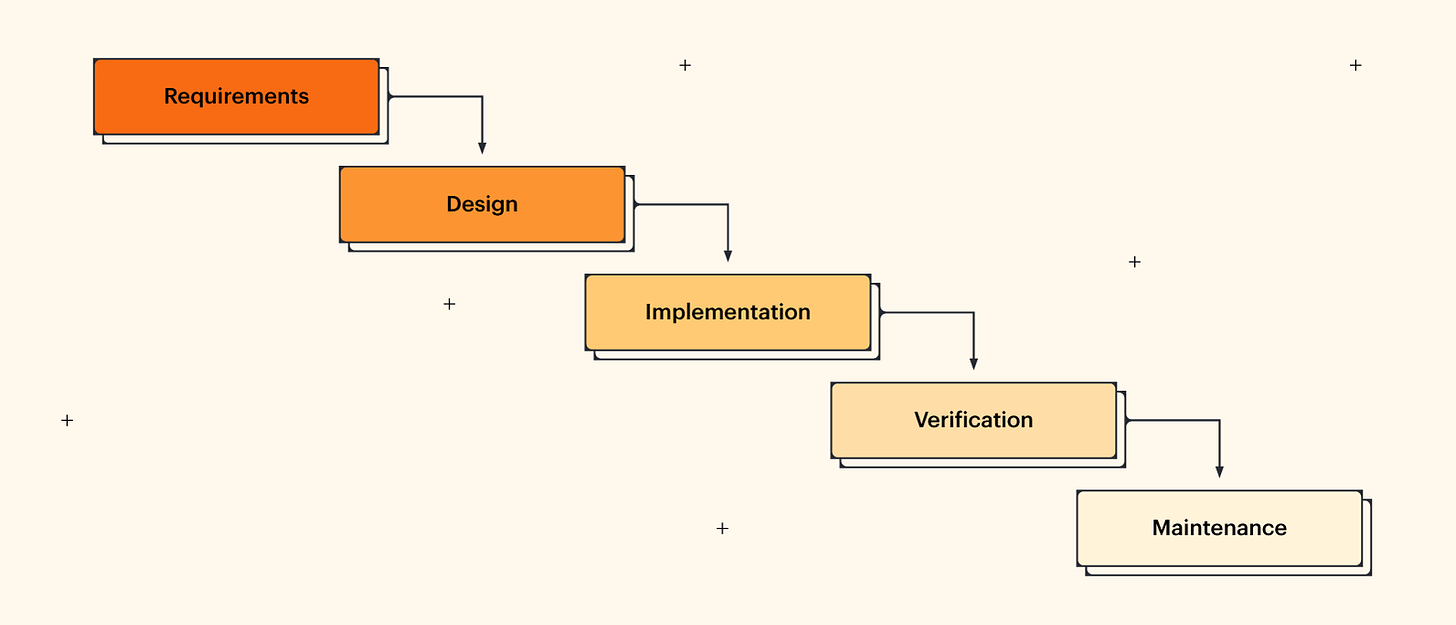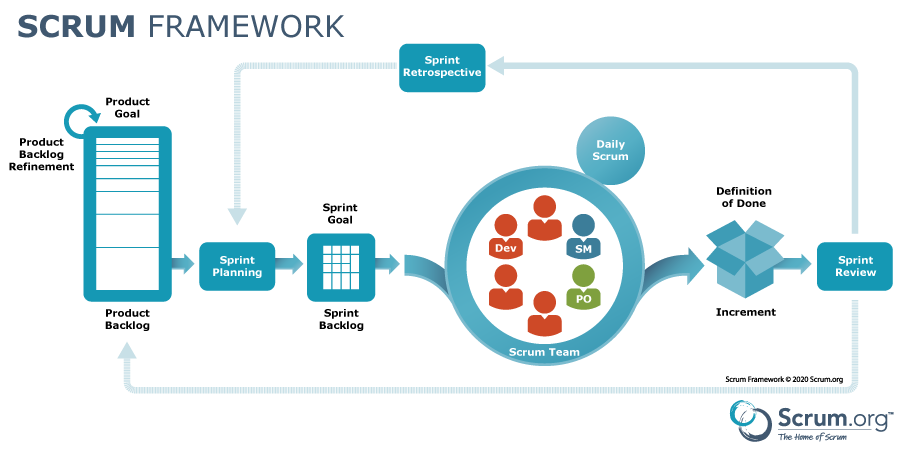Waterfall vs Agile (SCRUM): The 2 Workhorses of Digital Project Management
The pro's and con's of each method and how I've used them on two projects.
When you’re new to digital project management, knowing which methodology to use can feel daunting. I’ve no doubt you’re keen to cut your teeth on that magic bullet you’ve heard of called ‘Agile’. I certainly felt like that when I started out.
As a battle-scarred veteran of innumerable advertising campaigns and website overhauls, I've used two main methods the most consistently. With them, your colleagues will feel like they know ‘what’s next’ without confusion and I find that they likely fit most with your clients' workflows too.
With that said, enter….
Waterfall: The Grand Dame of Project Management.
Consider a stunning waterfall tumbling down in precise, predictable steps. That's the Waterfall approach in a nutshell: elegant, rigid, wonderfully predictable but about as adaptable as a starched shirt.
With this methodology, the idea is to complete one step of a project (the copywriting for example), get sign off internally and from the client then move on to the next step.
Source: Lucid Chart blog
That’s what it says on paper, but in the chaotic world of agencies and clients this is rarely the case.
Scope changes, more amends than you’d like come in, and that critical teammate you needed for the day called in sick.
Pros:
You’ll have a crystal-clear time plan up front: No surprises, just consistent steps from start to finish.
Familiarity: This method will most likely be the most familiar to them and (importantly), their own internal stakeholder. So it might need less education up front and make the job easier overall.
A tight scope: Accompanied by a detailed scope of work, this can be a powerful combination for project control. Handy for getting in some extra revenue if your client is happy with ‘change requests’.
Cons:
The flexibility of a brick: Try changing direction mid-project and watch your team break out in hives when they need to fit in extra work in order to keep the same timings.
Eleventh-hour testing drama: By the time you begin testing, making modifications feels like conducting heart surgery with a spoon.
Longer to release: Your client will be itching to get the project live and see results. So, needing to complete all the steps (from start to finish) before releasing something can (and usually) does take longer than Agile methods.
A story from the trenches
In 2014, I was working on a large (200+ page) corporate website rebuild using Drupal, which used to be a pretty inflexible CMS - once the design and content is defined you needed to stick to it.
We're discussing a digital Goliath here. We used Waterfall, breaking down the project into tidy, orderly phases such as requirements collecting, design, CMS specification, content migration, testing, and launch. It was like putting together a giant jigsaw puzzle, piece by piece.
We created a tightly-checked Scope of Work, a reasonable estimate and a beautiful looking Gantt chart time plan to match.
The project was going super-well. With a client who understood exactly what they wanted. We had the content signed off the core templates designed and our back-end developer humming along nicely for the Drupal side of things.
Then a senior stakeholder in the client compliance team came along late in the process.
Now there is a learning here in managing the client to get the right internal sign off at the right time, but that’s another story.
Anyway, we were thrown into a situation where content needed to change and, I saw my colleagues' face when they had to change the Drupal back halfway through. Not happy.
That’s the only problem with waterfall. It doesn’t handle change well unless your client doesn’t mind throwing in extra budget and more time or the project team doesn’t mind working weekends. Which they don’t.
If you want to learn more about Waterfall Project Management, then here are some other useful articles I found for you:
Article: What Is Waterfall Project Management? Phases, Benefits, & Uses
Article: Waterfall Methodology: A Complete Guide
Article: Marketing Strategies: Waterfall Model Advantages and Disadvantages
Next up…
Agile (SCRUM): The golden bullet of digital project management?
Let's now switch our focus to Agile, specifically SCRUM. If Waterfall is a classical symphony, Agile is an improvised jazz performance: vibrant, responsive, occasionally chaotic, but it creates moments of joy when it hits the mark.
First though, the best place to kick off your Agile journey is by looking at the Agile Manifesto and its wonderful set of principles. Go check it out.
I’ve included the SCRUM framework which will help you see the typical flow of a SCRUM project too.
Source: Scrum.org Agile Framework Poster
Pros:
Flexibility: Client has a change of plans? There's no sweat. SCRUM enables you to pivot by replanning the work and putt it into a future Sprint.
Client inside the cockpit: Clients, if fully involved with the process, including your daily stand-ups, sprint planning, backlog refinement and retrospectives, will help to make the project successful and feel like part of the team.
Sprint retrospectives: Speaking of retro’s. Working in SCRUM really encourages (and rewards) continual feedback amongst the team and improving the way you work through regular wash up meetings.
Cons:
Client NOT inside the cockpit: For the opposite reason of good collaboration with the client, not having them as present as part of the process can cause all sorts of issues. You don’t want them to think that just because you are working in ‘Agile’ that they can change what they like and whenever they like.
A slow start: You’ll need to be open-minded if your colleagues (and / or client) are new to working in Agile. You’ll need to set expectations up front as to how it will work and that feeling uncomfortable is OK. You may need to give the client some training on the process and ensure they can translate that back to their own internal stakeholders. In this situation, it would pay to get an external Scrummaster or Agile Coach on the team or at least checking in regularly to see how you’re getting on.
Where has my feature gone?: Your project might need to have a few ‘trade offs’ and it’s important your client knows exactly when this is happening and why. For example, a design for a particular feature is tied up in your clients' compliance department and it’s getting close to launch. You have an agreed budget in place. That feature might need to be built after the product has gone live and cost the client more money. But on the plus side, they are getting two more features that (although could be less important) will be part of the first release.
A story from the trenches
In 2022, I was leading a project to build a website for a healthcare client using SCRUM. This was a super-important project—clinical study sites needed a secure, easy-to-use platform to book appointments for their patients, request medical records, and work with our own call centre team to reach out to referrals that were becoming a bit ‘unresponsive’ to their phone calls.
We kicked things off with the client, breaking down the work into a product backlog and then into sprints.
Imagine it like this: every two weeks, we were delivering a new, working piece of the platform. Instead of trying to predict every little detail upfront, we focused on getting the essentials live first, then refining as we went along.
At first, things were going well. The initial sprints covered the basics—authentication, appointment scheduling, and a dashboard for study sites to view referral records. The client was involved, giving us feedback at the end of each sprint. It felt like we were on the right track, making progress in manageable, bite-sized chunks.
Then, midway through, a new regulation was introduced that required additional security measures. It could have been a showstopper. But because we were using SCRUM, we were able to adapt. We paused, brought the client into a sprint review, and reprioritised the backlog. The team adjusted the next few sprints to focus on integrating the new security requirements.
I remember the look on our lead developer’s face when we had to switch gears—but because we had built-in flexibility, we could absorb the change without derailing the entire project. We kept our regular cadence, hit our deadlines, and delivered the platform with all the necessary features.
That’s the beauty of Agile SCRUM. When change comes—and it always does—you’re not stuck in a rigid plan. You can pivot, keep the client in the loop, and still deliver on time without burning out your team.
If you're curious and want to learn more about Agile SCRUM then here are some other useful resources I found for you:
Article: The SCRUM guide on Scrum.org
Amazon: Essential Scrum by Kennith S Rubin.
Wrapping It Up: Choosing the Right Approach and Staying Flexible
As we’ve explored, both Waterfall and Agile (SCRUM) have their strengths and weaknesses. The key is knowing your project, your team, and your client well enough to pick the right tool for the job.
Whether you prefer the structured approach of Waterfall or the adaptable nature of SCRUM, the most important thing is to stay flexible, open-minded and collaborate—because in the ever-evolving world of digital projects, change is the only constant.
If you found this deep dive into project management useful, why not stick around? Subscribe for more insights, stories from the trenches, and tips to help you navigate the working on digital projects in the agency environment.





